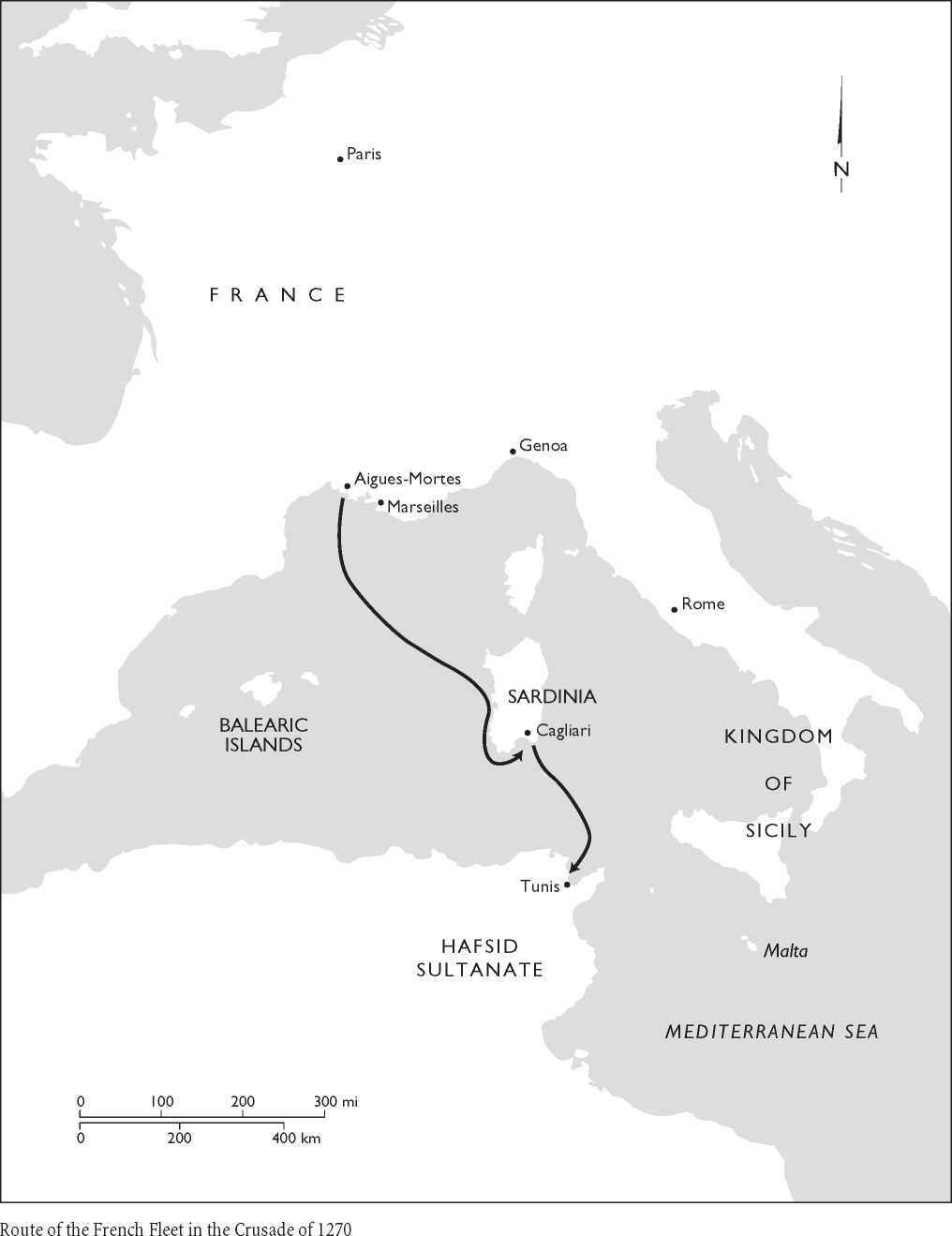The second crusade led by Louis IX, king of France. It culminated in an attack on the Muslim city of Tunis in North Africa, but failed to achieve anything of note. The 1260s saw an escalation of the military threat posed to Outremer by the Mamluk sultan of Egypt, Baybars I, who had captured a number of Frankish towns and fortifications and subjected

Acre (mod. ‘Akko, Israel) to frequent attack. In 1266 this news caused Pope Clement IV to proclaim a new expedition to the Holy Land, and toward the end of that year King Louis IX of France secretly informed the pope of his decision to undertake a new crusade to the East.
The king took the cross on 25 March 1267 at a ceremony to celebrate the feast of the Annunciation. Three of his sons, including his heir, Philip, also vowed to go on crusade, together with various barons. Many more took the cross when Prince Philip was knighted on 5 June 1267. Recent scholars have discounted the suggestion by the contemporary French chronicler John of Joinville that the crusade lacked support; agreements drawn up for the supply of shipping, and contracts made between the king and those lords who had committed themselves to the crusade, indicate that a figure of 10,000 participants is plausible.
The crusade was preached throughout France, first by Simon of Brie, the cardinal-bishop of St. Cecilia, and from 1268 by Ralph of Grosparmi, the cardinal-bishop of Albano, who was to accompany the crusade as papal legate. The king reduced his own household expenses to raise money for the expedition, but the biggest source of funds was the church. The pope granted Louis a tenth of the revenues from the church in France and a twentieth of the revenues from those dioceses that bordered the realm, for a period of three years. He was also awarded the income from the redemption of crusade vows and other ecclesiastical profits, and the pope actively encouraged private donations by awarding an indulgence to anyone who gave a quarter of their annual income to the crusade. Louis also secured money from the French towns by extending aid for the knighting of his son to cover the crusade as well. Louis contracted knights to serve with him for a year in the East; agreements specified the number of men and horses they were to bring and detailed the payment they would receive in return. Ships were commissioned and others chartered from the maritime cities of Marseilles and Genoa, which were to be ready to sail from the French port of Aigues-Mortes in May 1270. Finally, an admiral was named, Florence of Varennes, the first Frenchman to command a fleet.
In March 1270 Louis IX entrusted the government of France to the abbot of Saint-Denis and the lord of Nesle. On 14 March he received the pilgrim’s staff and the Oriflamme standard from the altar at Saint-Denis and on the following day left Paris. He arrived at Aigues-Mortes in May, but the ships were delayed and the fleet did not depart until the beginning of July 1270.
Much scholarly discussion has taken place over the intended destination of the crusade. It seems likely that the king had been persuaded of the possibility that the Hafsid sultan of Tunis, al-Mustansir, would convert to Christianity if an army were present to protect him from Muslim discontent. Louis evidently also hoped to undertake an offensive against Baybars in conjunction with Abagha, the Mongol Il-Khanid ruler. In 1270, Abagha faced a pressing military threat from a new quarter and postponed his planned campaign against the Egyptians. Motivated by piety, Louis used this unexpected delay to try to secure the conversion of al-Mustansir, while keeping his army together and possibly winning additional riches that could be used in the recovery of the Holy Land. This explanation accounts for the action in Tunis by establishing that it was not the final goal of the crusade but merely a staging post before the proposed campaign in Outremer.
The choice of Cagliari in Sardinia as the initial rendezvous point for the crusaders supports the thesis that Tunis was Louis’s intended goal for the first phase of the expedition. On 12 or 13 July the new plan was announced at a council meeting held there. It surprised most, but there was no significant opposition, and the fleet sailed for the North African coast. On 18 July 1270 the crusaders landed unopposed opposite Tunis. A lack of water forced them to move, and on 24 July they seized the town of Carthage and encamped outside it. The sultan made no move to convert, and Louis decided to await the arrival of his brother Charles I of Anjou, king of Sicily, before he attacked Tunis. While they waited, the Muslims harried the camp and disease broke out within the army. Many died, including John, one of Louis’s sons, and Ralph of Grosparmi, the papal legate. Louis himself fell ill, and on 25 August 1270, the very day that Charles of Anjou arrived, he died.
Charles took control of the crusade and succeeded in repulsing the Muslims, but the army had been so weakened by attack and disease that he decided to negotiate a withdrawal. On 30 October 1270, an agreement was reached. Charles was unable to secure freedom of worship for Christians in Tunisia, but the sultan conceded that they could preach and pray in their own churches. An indemnity of
210,000 ounces of gold was granted to the crusaders, and the sultan agreed to restore payment of the tribute owed to the kings of Sicily, but at double the previous amount, and to expel pro-Staufen refugees who had opposed Charles in Sicily. These latter concessions benefited Charles exclusively and helped to create the myth that he had influenced the direction of the crusade.
On 10 November 1270, Lord Edward of England, King Henry III’s heir, who had taken the cross in 1268 and in 1269 had arranged to join Louis IX’s expedition, finally arrived in Tunis. He had missed the opportunity to play a part in the expedition and was too late to have any influence on or to benefit from the agreement Charles had reached with the sultan.
The crusaders left Africa on 11 November 1270 and reached Sicily three days later. The original plan was apparently for Alphonse of Poitiers, another of the king’s brothers, to lead the remainder of the army to Syria in the following spring, while Philip, now king of France, returned to Paris. However, on the night of 15 November a storm destroyed the fleet, with the loss of 40 ships and at least 1,000 men, and it was decided that the crusade would be postponed. Only Lord Edward of England continued to Outremer.
-Linda Goldsmith
Bibliography
Dossat, Yves, “Alphonse de Poitiers et la preparation
Financiere de la croisade de Tunis,” in Septieme centenaire de la mort de Saint Louis: Actes des colloques de Royaumont et de Paris (21-27 mai 1970), ed. Louis Carolus-Barre (Paris: Les Belles Lettres, 1976), pp. 121-132.
Jordan, William C., Louis IX and the Challenge of the Crusade: A Study in Rulership (Princeton, NJ: Princeton University Press, 1979).
Longnon, Jean, “Les vues de Charles d’Anjou pour la deuxieme croisade de saint Louis: Tunis ou Constantinople?” in Septieme centenaire de la mort de Saint Louis: Actes des colloques de Royaumont et de Paris (21-27 mai 1970), ed. Louis Carolus-Barre (Paris: Les Belles Lettres, 1976), pp. 183-195.
Richard, Jean, Saint Louis: Crusader King of France (Cambridge: Cambridge University Press, 1992).
-. The Crusades, c. 1071-c. 1291 (Cambridge:
Cambridge University Press, 1999).




 World History
World History









